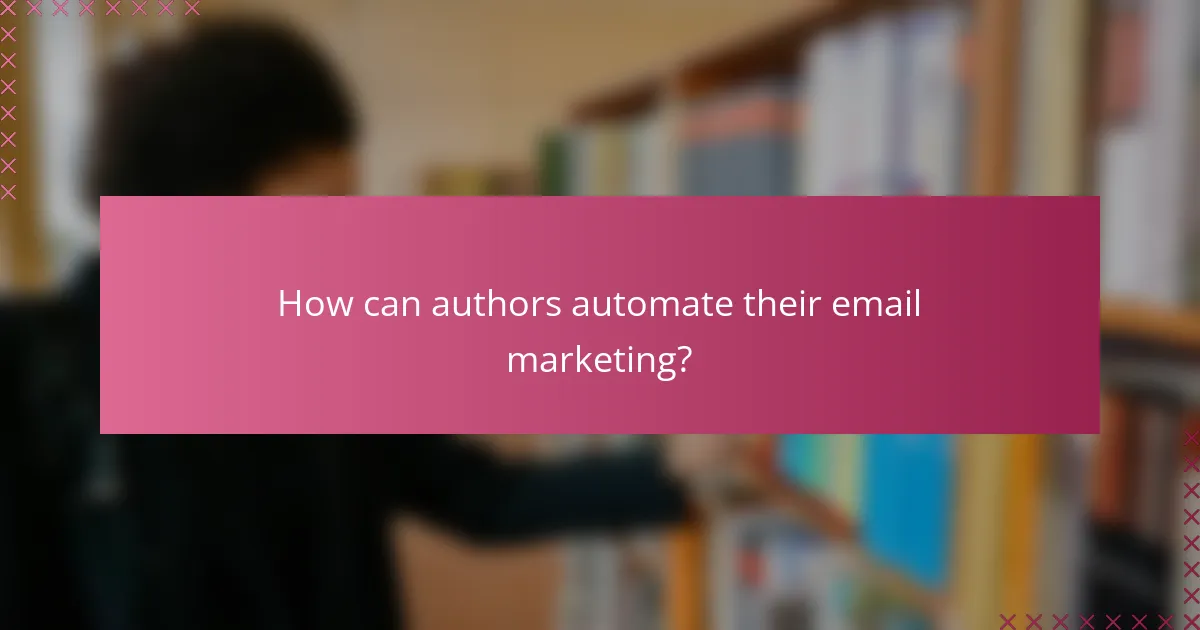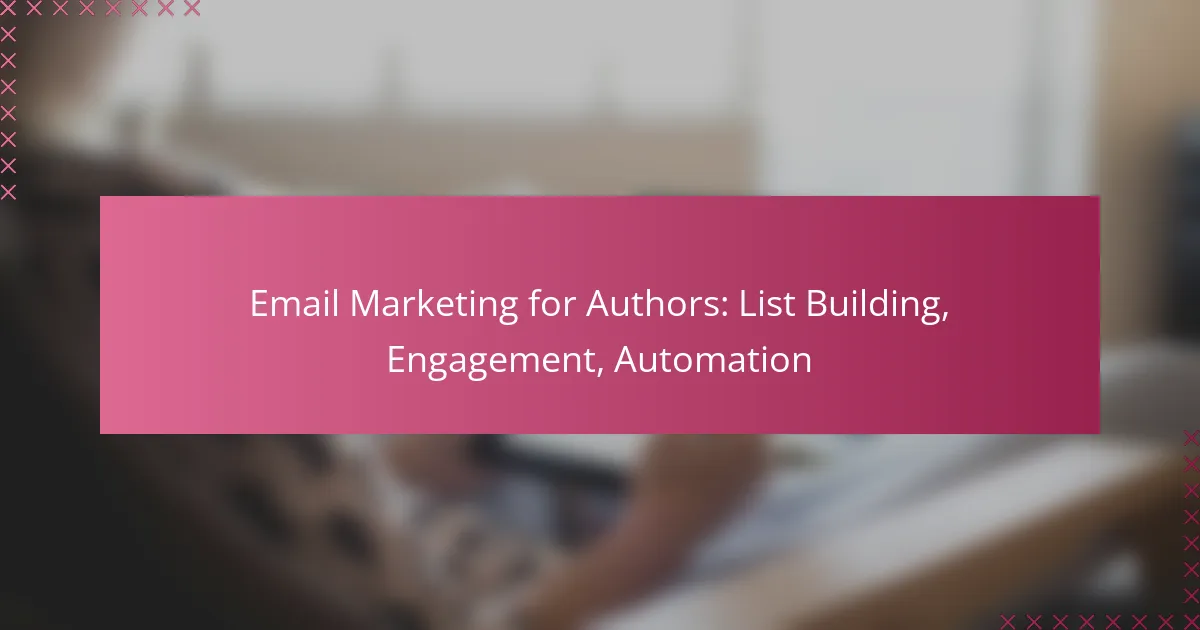Email marketing is a powerful tool for authors looking to connect with their readers and grow their audience. By building a targeted email list, engaging subscribers with personalized content, and automating communications, authors can create meaningful relationships that enhance their visibility and sales. Implementing these strategies not only saves time but also fosters a loyal reader base eager for new releases and updates.

How can authors build an email list effectively?
Authors can build an email list effectively by implementing strategic methods that attract potential readers and encourage sign-ups. Focus on providing value through engaging content and clear calls to action to convert visitors into subscribers.
Utilizing lead magnets
Lead magnets are valuable incentives offered to potential subscribers in exchange for their email addresses. Examples include free e-books, exclusive chapters, or downloadable resources related to your writing. Ensure that the lead magnet aligns with your audience’s interests to maximize sign-ups.
When creating a lead magnet, keep it relevant and high-quality. A well-designed lead magnet can significantly increase your conversion rates, turning casual visitors into loyal subscribers.
Creating landing pages
A landing page is a dedicated web page designed specifically for capturing email sign-ups. It should have a clear, compelling headline, a brief description of what subscribers will receive, and a simple sign-up form. Use persuasive language and visuals to enhance the appeal.
Optimize your landing page for mobile devices, as many users will access it from their phones. A clean layout with a strong call to action can boost your conversion rates significantly.
Leveraging social media
Social media platforms are powerful tools for promoting your email list. Share engaging content that highlights the benefits of subscribing, such as sneak peeks of upcoming books or exclusive offers. Use eye-catching visuals and direct links to your landing page.
Consider running targeted ads on platforms like Facebook or Instagram to reach a broader audience. Engaging with your followers through comments and messages can also encourage them to join your email list.
Offering exclusive content
Providing exclusive content to your email subscribers can incentivize sign-ups and maintain engagement. This could include behind-the-scenes updates, early access to new releases, or special discounts. Make it clear that this content is only available to subscribers.
Regularly update your exclusive offerings to keep your audience interested and engaged. This approach not only attracts new subscribers but also retains existing ones.
Networking with other authors
Collaborating with other authors can expand your reach and help you build your email list. Consider guest blogging, co-hosting webinars, or participating in joint promotions. This allows you to tap into their audience while providing value to your own.
When networking, focus on building genuine relationships rather than just seeking promotional opportunities. A strong network can lead to mutual support and increased visibility for both parties.

What strategies enhance email engagement for authors?
Authors can enhance email engagement by focusing on personalized content, audience segmentation, storytelling techniques, and incorporating reader feedback. These strategies help create a more meaningful connection with readers, leading to higher open and click-through rates.
Personalized content
Personalized content tailors emails to individual readers based on their preferences and behaviors. This can include addressing recipients by name, recommending books similar to their past purchases, or sending targeted content based on their interests.
To effectively personalize emails, authors can use data collected from sign-up forms or previous interactions. Simple strategies include using dynamic content blocks that change based on the recipient’s profile, ensuring each email feels unique and relevant.
Segmenting the audience
Segmenting the audience involves dividing your email list into smaller groups based on specific criteria, such as demographics, reading habits, or engagement levels. This allows authors to send tailored messages that resonate more with each group.
Common segmentation strategies include categorizing subscribers by genre preference, purchase history, or engagement frequency. By targeting specific segments, authors can increase the relevance of their emails, leading to improved engagement rates.
Utilizing storytelling techniques
Utilizing storytelling techniques in emails can captivate readers and foster a deeper emotional connection. Authors can share personal anecdotes, behind-the-scenes insights, or snippets from their works to create a narrative that draws readers in.
Effective storytelling can also include calls to action that encourage readers to engage further, such as sharing their thoughts on a character or plot twist. This not only enhances engagement but also builds a community around the author’s work.
Incorporating reader feedback
Incorporating reader feedback is essential for creating a responsive email strategy. Authors can solicit feedback through surveys, polls, or direct questions in their emails, allowing readers to express their preferences and opinions.
Actively using this feedback to shape future content can significantly enhance engagement. For instance, if readers express interest in a particular theme or topic, authors can tailor their upcoming emails to address these interests, ensuring continued relevance and connection.

How can authors automate their email marketing?
Authors can automate their email marketing by using specialized platforms that streamline tasks like sending newsletters, managing subscriber lists, and engaging readers. Automation helps save time and ensures consistent communication with fans while allowing authors to focus on writing.
Using platforms like Mailchimp
Mailchimp is a popular email marketing platform that offers automation features tailored for authors. It allows you to create and manage mailing lists, design visually appealing emails, and track engagement metrics. Many authors find it user-friendly, making it an excellent choice for those new to email marketing.
Consider exploring other platforms like Constant Contact or Sendinblue, which also provide robust automation tools. Compare their pricing and features to find the best fit for your needs.
Setting up autoresponders
Autoresponders are automated emails sent in response to specific actions, such as signing up for a newsletter. Authors can set up a welcome email series that introduces new subscribers to their work, offers a free sample, or shares insights about their writing process.
To maximize effectiveness, personalize these emails by addressing subscribers by name and segmenting your audience based on their interests. This targeted approach can lead to higher engagement rates.
Scheduling newsletters
Scheduling newsletters in advance allows authors to maintain a consistent communication schedule without manual intervention. Most email marketing platforms, including Mailchimp, enable you to set specific dates and times for your newsletters to be sent out.
Plan your content calendar at least a month ahead to ensure timely delivery of updates, promotions, or new releases. This helps keep your audience engaged and informed about your latest work.
Implementing drip campaigns
Drip campaigns are a series of automated emails sent over time to nurture leads or engage existing readers. Authors can use drip campaigns to gradually share excerpts from upcoming books, provide writing tips, or promote events like book signings.
To create an effective drip campaign, outline the sequence of emails and their content. Monitor engagement metrics to adjust your strategy as needed, ensuring that your messages resonate with your audience.

What metrics should authors track in email marketing?
Authors should track key metrics like open rates and click-through rates to gauge the effectiveness of their email marketing campaigns. These metrics provide insights into audience engagement and help refine strategies for better results.
Open rates
Open rates indicate the percentage of recipients who open an email. A typical open rate for authors can range from 15% to 30%, depending on the genre and audience engagement. Tracking this metric helps authors understand how compelling their subject lines are and whether their audience is interested in their content.
To improve open rates, authors should consider segmenting their email lists based on reader preferences and behaviors. Personalizing subject lines and sending emails at optimal times can also enhance open rates. Avoiding spammy language and maintaining a clean subscriber list are crucial to keeping open rates healthy.
Click-through rates
Click-through rates (CTR) measure the percentage of recipients who click on links within an email. For authors, a good CTR typically falls between 1% and 5%. This metric reveals how effectively the email content drives readers to take action, such as visiting a website or purchasing a book.
To boost click-through rates, authors should include clear and compelling calls to action (CTAs) in their emails. Using engaging visuals and concise text can also encourage clicks. Regularly testing different elements, such as link placement and wording, can help identify what resonates best with the audience.
